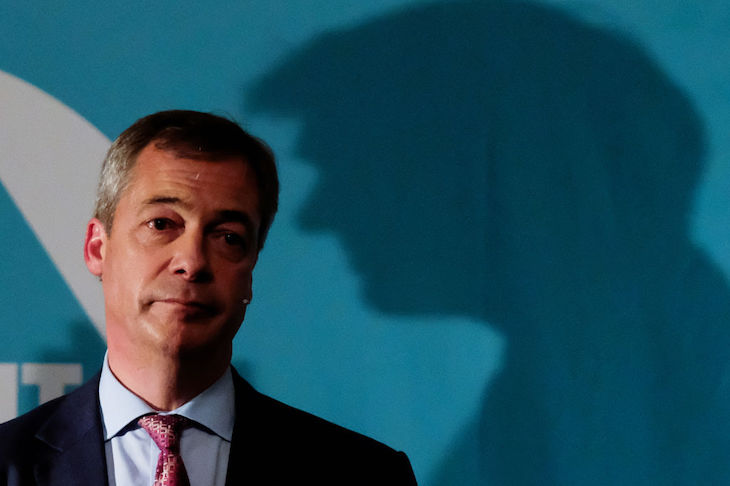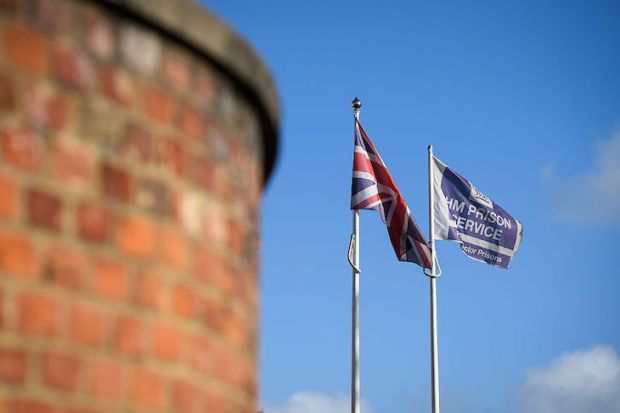Nigel Farage did a noble thing yesterday in agreeing to stand down Brexit Party candidates in the 317 seats the Tories won in 2017. Unfortunately, it isn’t sufficient to safeguard Brexit. If he fields candidates in Labour seats, which is his current plan, he could still do enough damage to deprive Boris Johnson of a majority and put Jeremy Corbyn in Number 10.
How so? Take the 317 seats the Conservatives won in 2017. Don’t forget, the Tories are now down to 298 MPs, so they’ll need to win 25 more to secure a working majority of 323. But in reality the party will have to make more gains than that because it won’t hold all of those 298.
How many seats is it likely to lose? I think it’s a safe bet it won’t lose anywhere the Labour Party were in second place in 2017. But the same cannot be said of those seats where the Lib Dems and the SNP came second. According to my calculations, if there’s a 7.5 per cent swing away from the Tory incumbent in seats where the Lib Dems came second last time, and a 7.5 per cent swing to the SNP in those seats where the SNP came second, the Conservatives will lose 20 seats – ten to the Lib Dems and ten to the SNP.
Factoring in those losses, the Conservatives will therefore have to win 45 seats to gain a working majority. Let’s assume the party wins back all 19 of the seats it has lost since 2017, including Brecon and Radnorshire which is currently held by the Lib Dems. That leaves the party still needing to win 26 seats.
Where are those gains going to come from?
Here’s a list of the 65 seats the Tories will win if there’s a 5 per cent swing away from the party that came second in 2017 towards the Conservatives. I’ve ranked them in order of winnability, with those requiring the smallest swing at the top. Note that I’ve excluded all those seats the Tories have lost since 2017:
- Perth and North Perthshire
- Kensington
- Dudley North
- Newcastle under Lyme
- Crewe and Nantwich
- Canterbury
- Barrow and Furness
- Keighley
- Lanark and Hamilton East
- Ashfield
- Stroud
- Bishop Auckland
- Peterborough
- Oxford West and Abingdon
- Westmorland and Lonsdale
- Colne Valley
- Ipswich
- Bedford
- Stockton South
- Edinburgh South West
- Warwick and Leamington
- Penistone and Stocksbridge
- Carshalton and Wallington
- Argyll and Bute
- Eastbourne
- Ayrshire Central
- Lincoln
- Portsmouth South
- Warrington South
- Derby North
- High Peak
- Battersea
- Wakefield
- Wolverhampton South West
- Wrexham
- Stoke on Trent North
- Dewsbury
- Vale of Clwyd
- East Lothian
- Kingston and Surbiton
- North Norfolk
- Reading East
- Gower
- Blackpool South
- Great Grimsby
- Linlithgow and Falkirk East
- Darlington
- Ayrshire North and Arran
- Weaver Vale
- Rother Valley
- Edinburgh North and Leith
- Cardiff North
- Newport West
- Bolton North East
- Scunthorpe
- North Fife East
- Bristol North West
- Enfield Southgate
- Gedling
- Bury North
- Bassetlaw
- Inverness, Nairn, Badenoch and Strathspey
- Workington
- Paisley and Renfrewshire North
- Croydon Central
Six of the MPs in these seats are Lib Dems and 12 are Scottish Nationalists. The Tories probably can’t win them. 47 are seats currently held by the Labour Party. It’s a safe bet that winning these 47 seats is a top priority for the Conservatives.
We know from recent polling data that the Tories cannot win all of these seats if the Brexit Party fields candidates in them. Take Portsmouth South, for instance, the 28th highest Conservative target. Survation recently did a constituency poll in Portsmouth South and it showed the CONs on 27 per cent, the LDs on 30 per cent, LAB on 24 per cent and the BP on 14 per cent. In other words, if the Brexit Party fields a candidate in Portsmouth South, the Lib Dems will win the seat.
Nigel Farage has claimed that in seats where there’s a sitting Labour MP, the Brexit Party will take more votes from Labour than the Conservatives, so if he fields candidates in those seats it will help the Tories. Unfortunately, that isn’t supported by the data. In a recent poll for the Mail on Sunday, Deltapoll asked respondents how they’d vote if the Brexit Party was standing in their constituency and how they’d vote if it wasn’t. When it was standing, support for the main parties broke down as follows: CONs 41 per cent, LAB 29 per cent, LD 16 per cent, BP 6 per cent. When it wasn’t, this changed to CONs 46 per cent, LAB 30 per cent, LD 17 per cent. In other words, the Brexit Party is attracting a lot more potential Conservative voters than potential Labour ones, so if it fields candidates in Labour constituencies it will help Labour, not the Tories. (H/t Matt Singh.)
Okay, let’s suppose Nigel accepts this analysis and doesn’t field any candidates in the 47 Conservative target seats. Are there any seats in which the Brexit Party is actually polling ahead of the Tories? Yes, according to an MRP analysis informed by a large YouGov poll of constituencies in England and Wales done in September/October. That analysis was done by Best for Britain, the organisation behind GetVoting.org, one of several pro-Remain tactical voting sites.
The political scientist Chris Hanretty was able to obtain this data and put it online here. It shows the Brexit Party ahead of the Conservatives in just seven seats:
Seat
Con
Lab
LibDem
Green
BXP
Plaid
Barnsley East
22.24%
30.89%
9.80%
7.33%
27.68% Hartlepool
25.27%
32.30%
9.24%
5.48%
25.67% Rotherham
23.21%
32.76%
11.52%
5.19%
25.27% Barnsley Central
22.45%
34.42%
10.38%
6.55%
23.85% Doncaster North
23.50%
36.24%
8.90%
5.24%
23.78% Rhondda
13.67%
34.42%
8.19%
4.09%
16.74%
20.65%
Liverpool, Walton
10.27%
58.11%
10.75%
5.30%
11.56%
That suggests it might be worthwhile for Nigel Farage to field candidates in those seats – and, indeed, Richard Tice has already said he’s going to stand in Hartlepool. However, in a more recent bit of MRP analysis, this time informed by a ComRes poll for RemainUnited.org, Gina Miller’s tactical voting website, the Brexit Party is behind in those seven seats.
Now, in five of these seven seats – Barnsley Central, Doncaster North, Liverpool, Walton, Rotherham and Rhondda – it doesn’t matter a great deal if the Brexit Party stands because the Conservatives’ chances of winning are slim. But Barnsley East would only require a three per cent swing from Labour to the Conservatives for the latter to win, based on the parties’ standing in this analysis. In Hartlepool, the two main parties are neck-and-neck and the Brexit Party is trailing by 14 points. It follows that if Richard Tice fell on his sword, Hartlepool would become a Conservative gain. Ideally, Farage won’t field candidates in either of those two seats.
I also looked at 46 other seats where Leave did well in the 2016 referendum and the Brexit Party did well in the 2019 European Election – the kind of seats where Farage may be considering running candidates. As I’ve already said, the Brexit Party aren’t ahead of the Conservatives in any of these seats according to analysis based on the YouGov poll or the one based on the more recent ComRes poll.
Based on the YouGov data, it would be a mistake for Farage to field candidates in some of these constituencies because the swing from Labour to the Conservatives required in these seats for the latter to win is ≤ 3 per cent (the swing from where the parties stood when the YouGov poll was done in Sept/Oct):
Swing from LAB to CON needed for CONs to win
Chesterfield
2.5
Doncaster Central
1.95
Hemsworth
1.5
Newcastle upon Tyne N
1.6
Normanton, Pontefract
2.9
North West Durham
1
Oldham East and Sadd
1.45
Stalybridge & Hyde
CONS ahead of LAB
Sunderland Central
1.6
Warrington North
2.6
Worsley & Eccles South
1.75
I then looked at the same 46 seats, only this time using the MRP analysis based on the ComRes poll. Based on this data, it would be a mistake for the Brexit Party to stand in the following constituencies because the swing from Labour to the Conservatives required in these seats for the latter to win is ≤ 3 per cent (the swing from where the parties stood when the ComRes poll was done):
Swing from LAB to CON needed for CONs to win Blaydon
3
Chesterfield
1.5
Doncaster Central
2.5
Hemsworth
1.5
Hull West and Hessle
3
Newcastle upon Tyne North
3
Normanton, Pontefract
3
North West Durham
1
Oldham East and Sad
3
Redcar
1
Stalybridge & Hyde
2.5
Sunderland Central
3
Torfaen
3
Warrington North
1
Wolverhampton SE
0.5
Worsley & Eccles South
1.5
It’s instructive that the 11 seats that appear to be winnable for the Tories with a swing of ≤ 3 per cent in the YouGov poll are also shown as being winnable with the same swing in the ComRes poll. The difference is that five more seats are now appearing in the Tories’ winnable column based on that metric – 16 in total.
This just leaves 30 Labour seats in Leave areas where fielding a Brexit Party candidate would be unlikely to do any damage to the Tories (the voting intention data is from the ComRes poll):
CON
LAB
LD
BP
Gn
PC
Aberavon
22
43
8
17
1
9
Ashton-under-Lyne
32
40
8
17
2 Barking
26
49
10
13
2 Barnsley Central
29
41
8
20
2 Birmingham Yardley
24
41
21
12
1 Bolton South East
30
45
6
16
2 Caerphilly
28
42
0
16
0
14
Denton & Reddish
30
41
10
17
2 Doncaster North
31
39
8
21
1 Easington
28
41
9
19
2 Houghton & SS
32
39
9
17
2 Hull East
31
38
9
20
2 Hull North
26
43
12
15
3 Islwyn
28
37
8
17
1
9
Leeds Central
22
50
9
13
5 Leeds
30
44
7
16
2 Llanelli
27
40
0
17
0
16
Merthyr Tydfil & Rhymney
23
41
8
17
1
10
Newcastle upon Tyne C
25
49
10
12
3 Newcastle Upon Tyne E
22
47
15
11
4 North Durham
31
40
11
16
1 North Tyneside
29
43
10
15
2 Ogmore
26
40
8
16
1
9
Oldham West & Royton
28
49
6
15
2 Rochdale
28
47
10
14
2 Rotherham
30
40
8
21
1 Sheffield South East
32
41
8
17
1 St Helens North
30
41
10
15
2 Swansea East
27
40
8
17
1
7
Walsall South
34
42
10
12
1 Wansbeck
32
39
12
15
2 Warley
28
47
11
12
2 Wigan
31
40
9
17
2
Two more seats, Liverpool Walton and Rhondda, could be added to this list as they were two of the seven seats where the Brexit Party was polling ahead of the Tories according to YouGov, but not ComRes.
In conclusion, if Nigel Farage is determined to field candidates in some Labour seats, he could do so in these 32 and not damage the Conservatives’ overall prospects. But he should not do so in the 47 Tory targets identified above, in Barnsley East and Hartlepool, or in the additional 16 constituencies in Leave-y areas where a swing of ≤ 3 per cent from Labour to the Conservatives, based on the latest polling data, would be enough to secure victory for the latter.
Of course, all this presupposes that Farage shares my desire to maximise the chances of Boris winning a majority. But judging from his actions yesterday, I’m sure he does. We cannot risk Jeremy Corbyn becoming Prime Minister, not least because it would mean the end of Brexit.
Got something to add? Join the discussion and comment below.
Get 10 issues for just $10
Subscribe to The Spectator Australia today for the next 10 magazine issues, plus full online access, for just $10.





















Comments
Don't miss out
Join the conversation with other Spectator Australia readers. Subscribe to leave a comment.
SUBSCRIBEAlready a subscriber? Log in